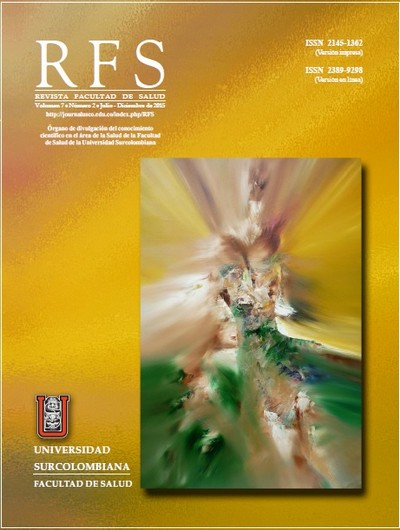Obscure gastrointestinal bleeding: “an unsuspected cause”
##plugins.themes.bootstrap3.article.main##
Obscure gastrointestinal bleeding is found in 5-10% of cases of intestinal bleeding, recurring in 50% of cases. It is caused by various aetiologies which can make diagnosis a challenge, requiring various endoscopic procedures. Among the unusual causes are nematode intestinal parasites, prevalent in tropical areas and developing countries. The study presents the case of a patient with recurrent obscure gastrointestinal bleeding triggered by Ascaris lumbricoides, who required various hospitalisations, blood transfusions and a set of endoscopic procedures before the aetiological diagnosis and subsequent treatment. This demonstrates the necessity to know the true cost-effectiveness of preventive parasite control in all patients with gastrointestinal bleeding and negative results for the first endoscopic evaluation, taking the high prevalence of nematodes in our country into account.
Downloads
##plugins.themes.bootstrap3.article.details##
Raju GS, Gerson L, Das A, et al. American Gastroenterological Association (AGA) Institute technical review on obscure gastrointestinal bleeding. Gastroenterology 2007;133:1697-717.
Fisher L, Lee Krinsky M, Anderson MA, et al. ASGE Standards of Practice Committee. The role of endoscopy in the management of obscure gastrointestinal bleeding. Gastrointestinal Endoscopy 2010;72:471-479.
Rondonotti E, et al. ASGE Diagnostic algorithm for obscure gastrointestinal bleeding: Eight burning questions from everyday clinical practice. Digestive and Liver Disease (2013);45:179-185.
Baños F. Sangrado gastrointestinal oscuro: ¿Cuál es el mejor abordaje diagnóstico? Rev Col Gastroenterol/2010;25(2).
Lui K, Kaffes A. Review article: the diagnosis and investigation of obscure gastrointestinal bleeding.Aliment Pharmacol Ther 2011;34:416-423.
Teshima C, Kuipers E, et al. Double balloon enteroscopy and capsule endoscopy for obscure gastrointestinal bleeding: An updated meta-analysis. Journal of Gastroenterology and Hepatology 2011;26:796-801.
Hartmann D, Schmidt H, et al. A prospective two-center study comparing wireless capsule endoscopy with intraoperative enteroscopy in patients with obscure GI bleeding. Gastrointest Endosc 2005;61:826-832.
Triester SL, Leighton JA, et al. A meta-analysis of the yield of capsule endoscopy compared to other diagnostic modalities in patients with obscure gastrointestinal bleeding. Am J Gastroenterol 2005;100:2407-2418.
Macdonald J, Porter V, McNamara D. Negative capsule endoscopy in patients with obscure GI bleeding predicts low rebleeding rates. Gastrointest Endosc 2008;68(6):1122-7.
Lai LH, Wong GLH, et al. Long-term follow-up of patients with obscure gastrointestinal bleeding after negative capsule endoscopy. Am J Gastroenterol 2006;101:1224-8.
Mergener K, Ponchon T, Gralnek I, et al. Literature review and recommendations for clinical application of small bowel capsule endoscopy, based on a panel discussion by international experts. Consensus statements for smallbowel capsule endoscopy, 2006/2007. Endoscopy 2007;39(10):895-909.
Viazis N, Papaxoinis K, Vlachogiannakos J, et al. Is there a role for second-look capsule endoscopy in patients with obscure GI bleeding after a nondiagnostic first test? Gastrointest Endosc 2009;69(4):850-6.
Agudelo S, Gomez L, et al. Prevalencia de Parasitosis Intestinales y Factores Asociados en un Corregimiento de la Costa Atlántica Colombiana. Rev. salud pública. 2008;10(4):633-642.
Chijioke A, Brown M. Intestinal nematodes: disease burden, deworming and the potential importance of coinfection. Current Opinion in Infectious Diseases 2008,21:516-522.
Knopp S, Steinmann P, et al. Nematode Infections: Soil-Transmitted Helminths and Trichinella. Infect Dis Clin N Am 2012;26:341-358.
Jia-Min Chen et al. Overt gastrointestinal bleeding because of hookworm infection. Asian Pacific Journal of Tropical Medicine 2012; pp. 331-332.
Stephen D, Siow S. Acute Lower Gastrointestinal Haemorrhage Secondary to Small Bowel Ascariasis. Malays J Med Sci. Apr-Jun 2012;19(2):92-95.
Lukashok H, Robles C. Multiple Intestinal Erosions as a Result of Hemorrhage due to Parasites: Case Reports and Review of the Literature. Diagnostic and Therapeutic Endoscopy. doi:10.1155/2011/340869.
Floro G, Pak L, Sreter, and Z. Tulassay. “Wireless capsule endoscopy in the diagnosis of helminthiasis (Brandt LJ commentary),” Gastrointestinal Endoscopy, 2007;65(7): 1078-1079, 2007.
P. Balachandran and V. G. M. Prasad. “Intestinal parasites seen on capsule endoscopy,” Gastrointestinal Endoscopy 64(4):651, 2006.
J. M. M. G. Soares, L. Lopes, G. Villas-Boas, and C. Pinho, “Ascariasis observed by wireless-capsule endoscopy,” Endoscopy, 2003;35(2):194, 2003.
A. J. Trindade and C. S. Pitchumoni. “Incidental detection of Ascaris lumbricoides by wireless capsule endoscopy,” Journal of Clinical Gastroenterology, 2006;40(3):226, 2006.










